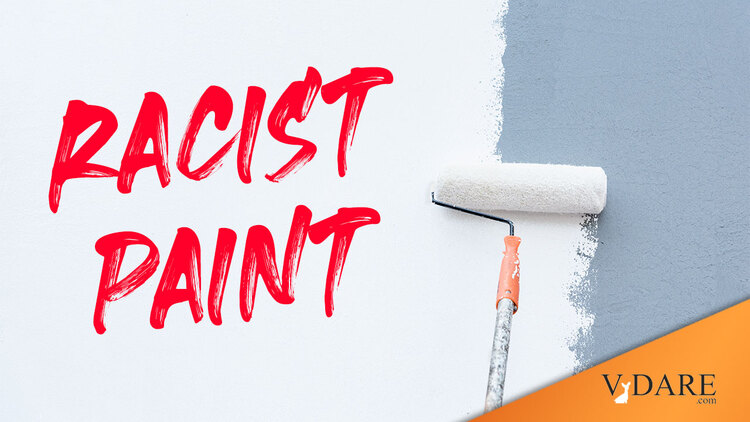
By Steve Sailer
02/13/2023
One of my recurrent themes is the growing childishness of intellectual discourse in the 21st century: e.g., the cartoonish division of humanity into Good Guys and Bad Guys based on how many Diversity Pokemon Points they have.
Children typically have a Favorite Color. Professors increasingly have a Least Favorite Color, which, you’ll be amazed to learn, always turns out to be white. For example, here’s a press release from Columbia University:
Professor Wendy Walters Wins 2020 Creative Capital Award
By Rochelle Goldstein
February 20, 2020Visiting Associate Professor Wendy S. Walters was recently awarded the prestigious Creative Capital award, given in support of innovative and adventurous artists. The lucrative prize will allow Walters to finish her long-term book project, a nonfiction work investigating “…white paint in aesthetic contexts [that] explore[s] the social and cultural implications of its use…”
White paint’s impact in “various architectures: the built environment, community and emotional landscapes” as a subject grew out of Walters’ irritation some years ago over “the frequency with which the walls of educational spaces are painted in white.” The work reflects her polyglot interests and leapfrogs through architecture, environmental and art history and consumer cultures, and her own personal experiences. Questions of design intersect with personal history in a number of surprising ways, and Walters also looks into why white paintings (in the fine arts) got named as milestones of modernism and/or minimalism.
Talking to Amy Wright of Guernica, Walters noted that she is also writing “about the industrial Midwest [where Walters is from], with an eye to how the black middle class fit(s) into that space… I am interested in the aesthetics of class experience, and the ways that industrial backdrop shapes perceptions of power and beauty.”
From Creative Capital:
A Dead White: An Argument Against White Paint
A Dead White is a book-length polemic against the use of white paint in both interior and exterior spaces. The argument will wind through a wide selection of works in architecture, manufacturing, art history, and consumer culture, engaging narratives related to its effect in the lived environment. …
Wendy S. Walters is an author whose work blends poetry, nonfiction cultural commentary, and lyric essays to explore themes of race, gender, environment, and belonging in America.
Professor Walters explains in a video:
As I tried to understand why my reaction to white paint was so strong, I discovered numerous examples of the way it figured into systems of erasure, exclusion, violence, and the masking of power in the social and natural world.
Note that this is a different academic project about how white paint is racist than the Norwegian one entitled “How Norway Made the World Whiter.”
Although Norway is not a conventional colonial power, this project will show how the country has played a globally leading role in establishing white as a superior color. Until now, however, this story has been lesser known to scholars and the public. NorWhite will connect the challenging topics: whiteness, technological innovation, and mass-exploitation of natural resources in a single case study.
The research project will study the Norwegian innovations the chemical compound titanium dioxide (TiO2) and the white pigment titanium white in a historical, aesthetic, and critical lens — focusing on how the innovations transformed surfaces in art, architecture, and design — in order to show how aesthetic — and thereby societal — transformation is driven by technological development. …
The patent for titanium dioxide (TiO2) manufacture allowed for the development of the titanium white pigment, which revolutionized the color industry by bringing onto the market a pure white, nontoxic paint that resisted discoloration due to dirt and rust. However, even though TiO2 was not — at the time — considered chemically toxic, it created conditions for the emergence of attitudes toward color that could be said to be socially toxic. These attitudes allowed hierarchies and dichotomies such as clean/filthy, modern/ nonmodern, and civilized/primitive to materialize in everyday surfaces …
The project examines how a Norwegian innovation — the white pigment titanium dioxide — not only led to an aesthetic desire for white surfaces, but was also connected to racist attitudes.
People used to be able to think of colors metaphorically:
This is a content archive of VDARE.com, which Letitia James forced off of the Internet using lawfare.